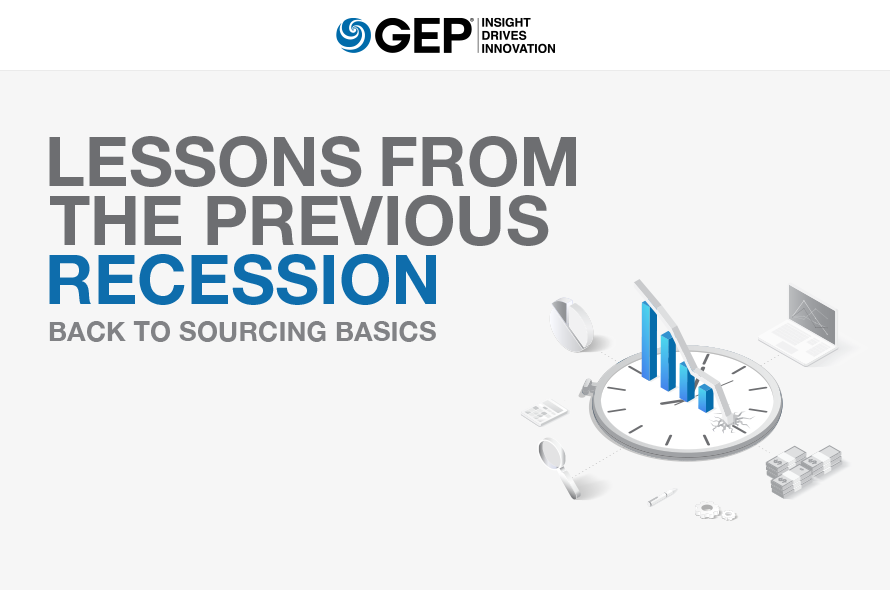Are your team’s efforts on cost savings going too far?
During a downturn, it’s easy for a procurement team to put emphasis on slashing costs. But it might be time to stop short-term moves. Time to re-focus on the ultimate prize: Creating business value.
Our latest paper, Lessons from the Previous Recession: Back to Sourcing Basics, is a timely reminder that procurement is a marathon, not a sprint. Inside, you’ll find six best practices that will help you find the right savings and ROI mix — without sacrificing business performance.
What’s Inside:
- How to leverage on-demand services and innovative technology
- How to organize your team and processes for success while minimizing risk
- How to boost cash flow and align supplier performance to KPIs
This paper is a must-read for procurement and sourcing professionals keen to create business value for their enterprises even during a recession.
OVERVIEW
An economic recession has returned to haunt countries across the world, including the United States. Amid this slowdown in economic activity due to the COVID-19 pandemic, businesses are reexamining cash flows, cutting spending and revising business strategies to survive and also thrive.
This white paper shares some of the best practices GEP has seen and helped leading client organizations implement to convert economic crises into opportunities and creators of immense business value.
THE BASICS OF HIGH-PERFORMANCE SOURCING
GEP has been closely involved in facilitating the procurement transformation journey at many global enterprises. Every best practice listed below has been implemented by most of our clients and has yielded them considerable business value.
Practice 1: Have the Right Organizational Framework
The function is highly complex and plays many roles – ensuring an uninterrupted flow of materials and services, generating year-on-year cost savings, developing integrated purchasing strategies and supporting overall organizational objectives. Adding to this layer of complexity is the fact that purchasing has extensive interfaces with other functions, such as manufacturing, marketing and research & development.
Companies should view the recession as a catalyst to push through structural changes in the procurement organization.
Efficiency and effectiveness in driving high performance across purchasing and related functions require the right foundational organization framework to strategize, execute, and manage this complexity. While the structure may vary from company to company, key building blocks remain the same:
- Enterprise-wide consistent procurement strategies, processes and practices
- Common technology platform enabling collaboration and visibility
- Purchasing reporting to the finance function
- Central category manager-based structure
- Well-defined roles and responsibilities, with best practice Key Performance Indicators (KPIs)
- Ownership of strategic sourcing and day-to-day procurement
- Global collaboration for key categories (IT, ocean freight, some direct materials)
Many organizations have used the economic recession as a catalyst to push through long - overdue structural changes in the procurement organization, and have found it easier to obtain internal stakeholder approval given the economic climate and internal pressures. Streamlining resources, roles, responsibilities and reporting structures will establish a strong foundation for procurement to thrive and to be better aligned with overall organizational objectives.
Practice 2: On-Demand Is in Demand
Market conditions during a recession generally put a lid on most investment plans and also generate greater management interest in the ROI of existing investments. This encourages the adoption and growth of on-demand services that enable organizations to optimize the investments made in technology and resources. Three key on-demand services that have seen greater adoption by procurement organizations that are performing well are:
1. On-demand technology
2. On-demand sourcing expertise
3. On-demand transactional services
Stop concentrating on cutting costs and start focusing on increasing the value you bring to the market. Even during a recession, companies and people still want/have to spend. The only difference is that they are more reserved and willing to hold out for products and services that provide great value at a great price.
On-demand technology includes cloud-native SaaS applications like AI-based and easy-to-deploy spend management platforms. The key reasons for their increased adoption are:
- No installation or capital investment
- Faster return on investment
- Short learning curve
- Pay-as-you-go pricing models
- Smooth integration with existing technology platforms
Instead of adding to existing staff, many organizations turn to flexible staff augmentation models, enabling access to subject matter experts on an as-needed basis. This is accomplished with the help of on-demand sourcing expertise. This extends some of the benefits mentioned for on-demand technology, to the “people” aspect (no capital investment, faster ROI, flexible pricing models and access to expertise, as needed.)
On-demand transactional services have not seen the same rate of adoption as technology and sourcing expertise, given the level of upfront planning needed and the longer time to value. However, our experience shows that companies that invest time and effort in identifying the right partner to manage their transactional services and prepare the detailed workflows necessary for success see significant business value by outsourcing administrative tasks like requisition creation, PO processing, and invoice management.
Practice 3: Spur Innovation
Traditionally, sourcing teams have focused primarily on price negotiations as the key business driver to identify cost savings. However, many sourcing professionals have now started expanding their role to include several more ways to add value. After most categories have been through a few rounds of strategic sourcing, the law of diminishing returns can set in, which involves revisiting specifications.
However, sourcing professionals can identify considerable savings through innovative strategies, such as specification improvement, brand substitution, and service-level redesign. This requires a lot of collaboration with R&D, manufacturing and other functions, but the results typically justify the costs and efforts involved. Demand management is another way to unlock value – if the procurement department collaborates with manufacturing and sales, considerable benefits follow. Any enhancement at this stage (inventory level change, product shipping time and method change, reduced consumption) can yield considerable levels of cost reduction, much greater than the savings identified by cost negotiations only.
Practice 4: Plug the Leakage, Now
Savings leakage due to limited compliance is a key concern for most companies. The most common reasons for lost savings opportunities are:
- Too much “savings” focus and not enough “service” focus during supplier selection
- Underestimating the challenges of change management
- Gaps in communication and implementation follow-through
- No visibility into vendor performance post sourcing
- No mechanism to track realized savings versus projected savings
Best-in-class organizations have shifted a lot of their efforts from simply “identifying” savings to “realizing” savings. Key strategies used by leaders to plug the savings leakage are:
- Involving multiple stakeholders at each stage of the sourcing process
- Linking performance metrics to the identification and realization of planned savings
- Striking the right balance between cost savings and service levels
- Including upfront planning on change management and implementation during a supplier switch
- Keeping procurement engaged beyond contract signing to ensure savings and value capture
- Establishing clear KPIs with respect to vendor performance, and savings tracking and validation
- Without a strong governance mechanism in place, an organization can easily traverse back to its past levels of inefficiency, and a lot of the good work can go in vain. A robust technology base can help enable reporting, and monitoring internal compliance at several levels.
Practice 5: Manage Cash Flow Through Procurement Levers
Large enterprises deal with hundreds of suppliers and thousands of invoices every day. However, many of these companies are unable to fully leverage the untapped value in their ordering and payable functions. Paper invoices, manual verification and approval processes, delayed payments, and absence of technology enablers are some of the challenges inhibiting procurement transformation. In our experience, many companies can unlock tremendous value from their accounts payable functions by implementing the following best practices:
- Ensure strict adherence to contractual payment terms; avoid penalties due to delays, or lost opportunities due to pre-payments.
- Evaluate the benefits of renegotiating pre-payment terms — contrary to conventional thinking, many companies can realize significant benefits through early supplier payments, as long as suitable discounting terms have been negotiated; this can help preserve the suppliers’ health while generating good short-term returns for the company
- Evaluate the viability of introducing third-party financing — this facility will allow a third party to finance accelerated payment to suppliers at low rates and enable an extension in metrics like Days Payable Outstanding (DPO); such a strategy can reduce supply chain risk and lower net working capital needs. Multiple groups, including treasury, finance, AP and procurement, have an impact on an organization’s ability to manage working capital effectively, but these groups often work in silos. While each group has it own goals, the entire organization must be aligned to gain maximum working capital efficiencies.
Practice 6: Mitigate Supply-Side Risks
While companies struggle with economic decline, many suppliers feel a greater pinch. Organizations require a proactive and predictive strategy toward supplier risk management. It is critical to identify such suppliers who could be impacted severely by the crisis and put risk mitigation plans in place. These plans could include continued monitoring of the financial status of suppliers, identifying alternative suppliers, reevaluating inventory levels, providing short-term assistance through payment terms adjustments, etc. Similarly, if business volumes are forecast to be low for the short-to-medium term, companies should review volume commitments to suppliers under longer-term agreements, and be proactive in discussing and changing requirements with suppliers. Senior-level discussions should be arranged with critical suppliers to share risks and rewards.
During an economic crisis, we should guarantee the supplier’s survival to ensure supply chain smoothness and constant working progress, even during this recovery period. Procurement organizations and professionals actively understand, foresee, and calculate the market condition and help companies manage their supply chain.
In conclusion, previous economic downturns have shown that procurement plays a key role in any cost reduction initiative. Best-in-class procurement organizations should use this opportunity to not only generate short-term savings, but also build long-term sustainable competitive advantage. And transforming procurement into a competitive advantage depends not on one radical new technology or a re-structuring exercise, but on getting the basics right across all procurement aspects:
- Having the right organizational structure
- Planning and collaborating with other functions, using technology and external resources based on the organizational needs
- Striking the right balance between service and price
- Effective supplier relationship management, managing cash flow, etc.
As leading procurement organizations have shown, the sum of these parts is usually much more than the whole.











